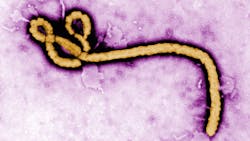Cal/OSHA Issues Interim Guidelines to Protect Health Care Workers from Ebola
Training, proper PPE and isolation rooms for donning and doffing protective gear are among the recommendations that Cal/OSHA makes to protect health care workers from Ebola, in guidance issued last week.
“California’s workplace safety and health standards go further than national standards in protecting workers from hazards such as Ebola,” said Juliann Sum, acting chief of Cal/OSHA. “We urge employers and their workers who may be at risk to pay careful attention to our guidance and check for updates as new information becomes available.”
Cal/OSHA and the California Department of Public Health have issued interim guidelines for health care workers, emergency responders, airline flight crews, laboratory staff and other professions that face the potential risk of exposure to Ebola.
The new guidance recommends that employers:
- Ensure that workers at risk of exposure to Ebola wear gloves, impermeable body coverings, face shields or other eye and face protection, and appropriate respiratory protection. All PPE must be adequate to prevent the passage of bodily fluids to the employee’s clothing and skin. NIOSH-approved respirators must be used where infectious aerosols are likely to be present.
- Train employees in the use of all applicable protective equipment, including respirators. Employees must be clearly instructed on how to safely put on and take off equipment.
- Give employees opportunities to practice with the respirators and other equipment they will use.
- Provide dedicated, separate areas for the donning and removing of protective gear.
- Use a buddy system or other means of assisting employees in donning and removing PPE. Employees who assist in removing contaminated equipment also must use PPE.
- Provide additional protective gear, such as double gloves and disposable shoe and leg coverings, in environments where copious amounts of blood, vomit, feces or other bodily fluids are present.
- Ensure that workers conducting aerosol-generating procedures such as intubation or bronchoscopy perform the procedures in an airborne infection isolation room, if feasible, or at least in a private room with the door closed. Employees exposed to these procedures must use NIOSH-approved respirators.
Cal/OSHA reminds all employers and workers that any suspected cases of Ebola must be reported promptly to the local public health department.
In 2009, California adopted an occupational health regulation that specifically addresses infectious diseases such as Ebola, which can spread by small liquid droplets that might come in contact with mucous membranes. The regulation, known as the Aerosol Transmissible Diseases Standard, helped inform Cal/OSHA’s new guidelines, the agency said.
Ebola is transmitted through direct contact with the blood or bodily fluids of an infected symptomatic person or through exposure to objects that have been contaminated.
